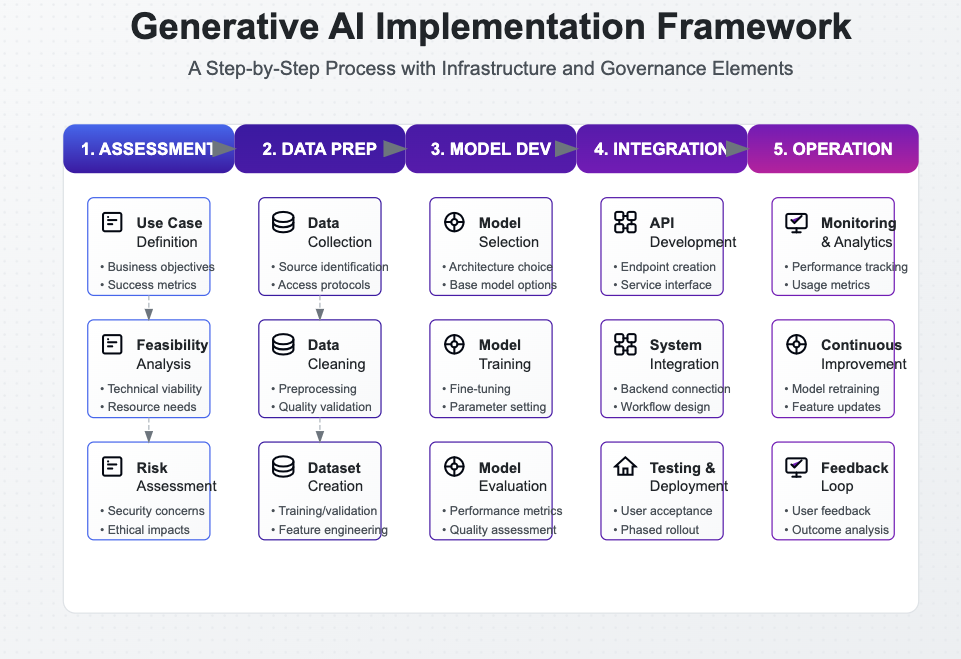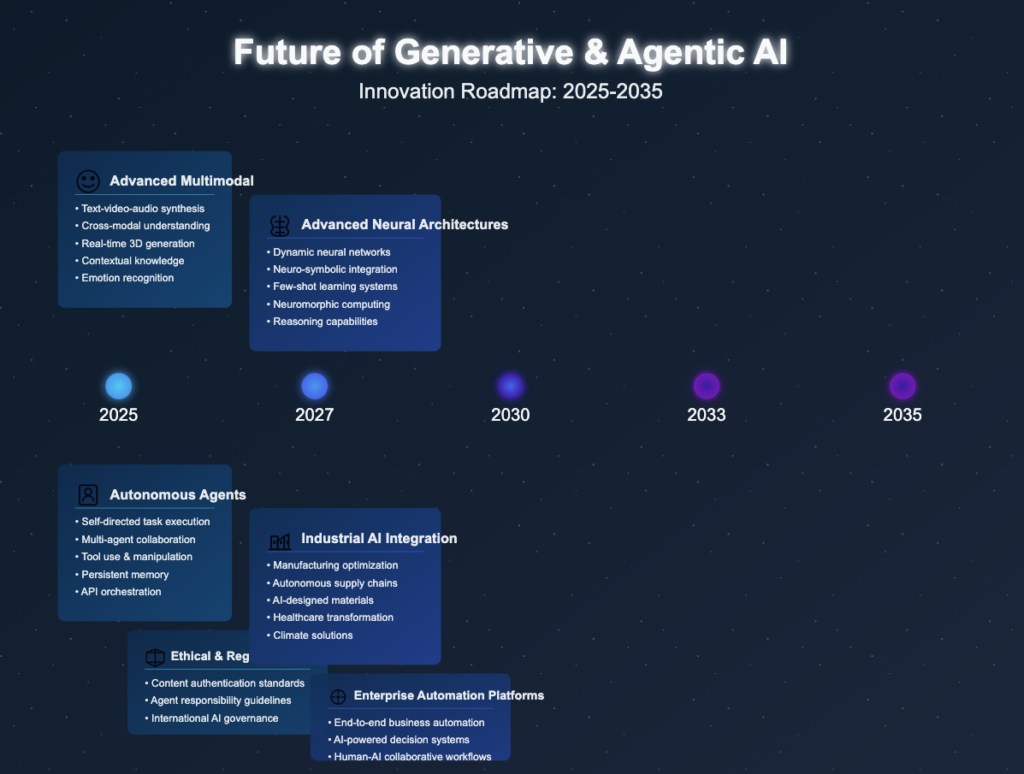Automation is no longer a question of “if,” but “how.” As enterprises race to integrate artificial intelligence into their digital strategies, the debate around generative vs agentic AI takes center stage. While both technologies push the boundaries of business automation, their true power lies in how they complement each other. Generative AI excels in creativity and pattern recognition, while agentic AI drives autonomous decisions and seamless process execution.
For leaders navigating enterprise digital transformation, understanding how these AI types work together is paramount. From accelerating productivity with generative AI to long-term optimization through agentic capabilities, combining the two offers unparalleled opportunities to redefine efficiency and innovation. Let’s explore how hybrid AI solutions are reshaping the automation landscape—and how your organization can stay ahead of the curve.
Key Takeaways
- Complementary Technologies: Generative and agentic AI work synergistically in enterprise environments, with generative AI excelling at content creation and pattern recognition while agentic AI handles autonomous decision-making and process execution.
- Hybrid Implementation Benefits: Combining both AI types creates comprehensive automation solutions that can both generate creative outputs and make independent operational decisions, maximizing digital transformation outcomes.
- Enterprise Integration Strategy: Successful implementation requires a phased approach, starting with generative AI for content and analysis tasks, then incorporating agentic AI for autonomous process optimization and decision-making.
- ROI Considerations: Generative AI typically shows faster initial returns through immediate productivity gains, while agentic AI delivers long-term strategic value through improved decision-making and process automation.
- Technical Infrastructure: Organizations need robust data architecture and processing capabilities to support both AI types, with particular attention to real-time processing for agentic AI systems.
- Risk Management: While generative AI primarily poses content accuracy risks, agentic AI requires additional safeguards for autonomous decision-making capabilities and system controls.
- Skill Requirements: Teams need distinct expertise for each AI type – creative and content expertise for generative AI, and process optimization skills for agentic AI implementation.
- Future Scalability: Hybrid AI solutions offer greater adaptability to changing business needs, with the ability to expand capabilities in both creative generation and autonomous operations.
Understanding the fundamental differences between generative vs agentic AI has become critical for enterprise leaders navigating digital transformation. As AI technologies evolve, the distinction between systems that create content and those that take autonomous action represents a strategic decision point for organizations seeking competitive advantage. This article explores how these AI approaches differ, where they excel, and how forward-thinking enterprises can implement them effectively.
Defining Generative AI vs Agentic AI: Core Differences

Generative AI refers to artificial intelligence systems designed to create new content based on patterns learned from training data. These systems excel at producing text, images, code, and other media that mimic human-created content. The technology behind generative AI includes large language models (LLMs) like GPT-4, which can generate human-like text responses to prompts.
In contrast, agentic AI systems are designed to take autonomous actions to achieve specific goals. Unlike generative AI, which primarily responds to prompts, agentic AI can initiate actions, make decisions, and interact with other systems to complete tasks without continuous human guidance. These systems combine generative capabilities with planning, reasoning, and execution functions.
The key differences between these artificial intelligence types include:
- Autonomy level: Generative AI requires human prompts and direction, while agentic AI can operate independently once goals are set
- Decision-making: Generative AI suggests or creates content but doesn’t make decisions; agentic AI evaluates options and selects actions
- System interaction: Generative AI typically operates within its own environment; agentic AI can interact with multiple systems and APIs
- Feedback loops: Agentic AI incorporates feedback from its actions to improve future performance
According to a 2023 McKinsey report, organizations implementing agentic AI solutions reported 35% higher operational efficiency compared to those using only generative AI tools.
Capabilities and Limitations of Generative AI in Enterprise Settings
Generative AI has transformed how enterprises approach content creation, data analysis, and customer interactions. These systems excel at processing and synthesizing vast amounts of information to generate human-like outputs across multiple formats.
Key Capabilities of Generative AI
Content creation represents one of generative AI’s strongest applications, enabling enterprises to produce marketing materials, reports, and documentation at scale. These systems can also perform data analysis and summarization, condensing complex information into accessible formats for decision-makers.
In customer-facing roles, generative AI powers conversational interfaces that handle routine inquiries and provide personalized responses. For technical teams, these systems assist with code generation and debugging, accelerating software development cycles.
A financial services firm implemented generative AI for regulatory compliance documentation and reduced report generation time by 78% while improving accuracy by 23%.
Limitations in Enterprise Applications
Despite its strengths, generative AI faces significant constraints in enterprise environments. These systems lack a true understanding of the content they produce, sometimes generating plausible-sounding but incorrect information (hallucinations). They also require continuous human oversight to ensure outputs align with business objectives and accuracy standards.
Generative AI struggles with complex decision-making that requires weighing multiple factors or understanding nuanced business contexts. Additionally, these systems cannot independently take action on their outputs or integrate with enterprise systems without significant custom development.
For enterprises implementing AI automation solutions, these limitations necessitate careful planning around human-in-the-loop processes and quality control mechanisms.
Capabilities and Limitations of Agentic AI in Enterprise Settings
Agentic AI represents the next evolution in enterprise AI implementation, moving beyond content generation to autonomous action. These systems combine generative capabilities with decision-making frameworks that enable them to execute complex workflows with minimal human intervention.
Key Capabilities of Agentic AI
The defining feature of agentic AI is its autonomous execution capability—the ability to plan and complete multi-step tasks across different systems. These autonomous AI systems excel at process automation, handling end-to-end workflows that previously required multiple human touchpoints.
Agentic AI demonstrates adaptive problem-solving, adjusting approaches based on changing conditions or unexpected obstacles. These systems can also perform continuous optimization, learning from outcomes to improve future performance without explicit reprogramming.
A manufacturing company deployed agentic AI to manage supply chain disruptions, resulting in a 42% reduction in inventory costs and 28% fewer stockouts during a six-month pilot program.
Limitations in Enterprise Applications
Despite their advanced capabilities, agentic AI systems face several challenges in enterprise environments. Implementation complexity remains high, requiring significant technical expertise and system integration work. These systems also present governance challenges as their autonomous nature raises questions about oversight, accountability, and control mechanisms.
Security considerations become more pronounced with agentic AI, as these systems typically require broader access permissions to execute tasks across multiple platforms. Additionally, the explainability gap can make it difficult for organizations to understand how agents arrive at decisions or troubleshoot unexpected behaviors.
For CTOs and innovation directors, these limitations highlight the need for robust governance frameworks and phased implementation approaches when deploying agentic AI solutions.
Strategic Implementation: When to Use Generative vs Agentic AI
Selecting the appropriate AI approach requires aligning technology capabilities with specific business objectives and operational contexts. The decision between generative and agentic AI – or a combination of both-should be guided by use case requirements, organizational readiness, and risk tolerance.
Optimal Use Cases for Generative AI
Generative AI delivers maximum value in scenarios requiring content creation and enhancement at scale. Marketing departments leverage these systems for campaign content, product descriptions, and social media posts. Knowledge-intensive organizations use generative AI for information synthesis and summarization, extracting insights from large document collections.
Customer service operations benefit from generative AI’s conversational support capabilities, handling routine inquiries while escalating complex issues to human agents. For creative teams, these systems serve as ideation partners, generating concepts and variations that spark human creativity.
A retail organization implemented generative AI for product description creation, reducing time-to-market for new items by 65% while maintaining a consistent brand voice across thousands of SKUs.
Optimal Use Cases for Agentic AI
Agentic AI excels in scenarios requiring end-to-end process automation with minimal human intervention. Operations teams deploy these systems for complex workflow management spanning multiple systems and decision points. IT departments leverage agentic AI for infrastructure monitoring and management, automatically detecting and resolving issues before they impact users.
In data-intensive environments, agentic AI enables continuous intelligence applications that monitor information streams, identify patterns, and take appropriate actions. Customer experience teams implement these systems for personalized journey orchestration, dynamically adjusting interactions based on customer behavior and preferences.
Before implementing either approach, organizations should conduct a thorough assessment of their AI digital transformation readiness, including data infrastructure, technical capabilities, and governance frameworks.
Enterprise Implementation Framework for Generative AI

Implementing generative AI effectively requires a structured approach that addresses technical, organizational, and governance considerations. This framework provides a roadmap for enterprise digital transformation leaders seeking to maximize value from generative AI investments.
Technical Infrastructure Requirements
The foundation of successful generative AI implementation begins with data preparation and management. Organizations must establish processes for collecting, cleaning, and structuring the data that will train or fine-tune generative models. Computing resources represent another critical consideration, with options ranging from cloud-based AI services to on-premises infrastructure for sensitive applications.
Integration capabilities determine how effectively generative AI connects with existing enterprise systems. APIs, middleware, and custom connectors may be required to incorporate AI outputs into business workflows. Organizations must also implement monitoring and evaluation systems to track model performance, detect drift, and ensure outputs meet quality standards.
A healthcare organization built a hybrid infrastructure for their generative AI implementation, using cloud resources for non-sensitive applications while maintaining on-premises deployment for patient data processing, reducing compliance risks while optimizing costs.
Governance and Risk Management
Effective governance begins with clear usage policies that define appropriate applications, required approvals, and usage boundaries for generative AI. Output review processes establish mechanisms for validating AI-generated content before it reaches external audiences or influences business decisions.
Organizations must develop bias monitoring and mitigation approaches to identify and address potential fairness issues in AI outputs. Compliance frameworks ensure generative AI usage aligns with regulatory requirements, industry standards, and organizational ethics guidelines.
When implementing generative AI, organizations should consider starting with open-source large language models for non-critical applications before expanding to more sensitive use cases.
Enterprise Implementation Framework for Agentic AI
Implementing agentic AI requires a more comprehensive approach than generative AI due to its autonomous nature and broader system access requirements. This framework addresses the unique challenges of deploying AI automation solutions that can take independent action.
Technical Infrastructure Requirements
Agentic AI implementation begins with establishing secure API connections that enable agents to interact with enterprise systems while maintaining appropriate access controls. Organizations must develop agent orchestration platforms that coordinate multiple agents, manage workflows, and handle exceptions.
Testing environments are essential for validating agent behaviors before deployment to production systems. These environments should simulate real-world conditions while providing safeguards against unintended consequences. Monitoring and control systems provide visibility into agent activities and enable human operators to intervene when necessary.
A financial services firm created a progressive permission model for their agentic AI implementation, starting with read-only access to systems before gradually expanding capabilities as confidence in the agent’s decision-making increased.
Governance and Risk Management
Agentic AI governance requires defined authority boundaries that clearly specify what actions agents can take independently versus those requiring human approval. Audit trails and logging capture all agent activities, decisions, and their rationales to support accountability and troubleshooting.
Organizations must establish intervention protocols that define when and how humans should override agent actions or decisions. Regular performance reviews assess agent effectiveness, identify improvement opportunities, and validate alignment with business objectives.
For organizations beginning their journey with AI decision-making capabilities, starting with narrowly-scoped agents focused on specific business processes provides a lower-risk path to building organizational confidence.
Combining Generative and Agentic AI for Maximum Business Impact
Forward-thinking enterprises are discovering that the most powerful AI implementations combine generative and agentic capabilities in complementary ways. This integrated approach leverages the content creation strengths of generative AI with the autonomous execution capabilities of agentic systems.
Hybrid Implementation Models
The agent-augmented generation model uses agentic AI to enhance generative outputs by gathering additional information, validating facts, or customizing content based on specific contexts. Conversely, the generation-powered agency model employs generative AI to improve agent communications, reasoning, and explanation capabilities.
Workflow orchestration approaches use agentic AI to coordinate processes while deploying generative AI for specific content creation tasks within those workflows. Human-AI collaborative frameworks position AI systems as team members that handle routine tasks while escalating complex decisions to human experts.
A professional services firm implemented a hybrid model where agentic AI managed client research workflows while generative AI produced draft reports, reducing project completion time by 47% while maintaining high quality standards.
Integration Best Practices
Successful integration begins with a clear role definition between generative and agentic components, establishing which system handles specific tasks and how they interact. Consistent data models ensure both systems operate from the same information foundation, reducing conflicts and inconsistencies.
Organizations should implement unified monitoring that provides visibility across both AI types, tracks performance metrics, and identifies potential issues. Staged implementation approaches allow teams to build experience with generative AI before adding agentic capabilities, reducing implementation risks.
When combining generative and agentic AI for business transformation, organizations should prioritize use cases that leverage the strengths of both approaches while addressing clear business needs.
Measuring ROI and Business Impact of AI Implementations
Quantifying the return on investment for AI initiatives requires a comprehensive measurement framework that captures both direct financial impacts and broader organizational benefits. This approach helps digital transformation leaders justify AI investments and optimize implementation strategies.
Key Performance Indicators for Generative AI
Productivity metrics measure time savings and output increases resulting from generative AI implementation. Organizations track metrics like content production time, revision cycles, and volume of materials produced. Quality indicators assess improvements in consistency, accuracy, and compliance of AI-generated outputs compared to human-only processes.
Cost efficiency measures quantify resource savings from automating content creation tasks, including reduced staffing requirements and lower production costs. User adoption metrics track how effectively teams incorporate generative AI into their workflows, including usage frequency and satisfaction ratings.
A media company implementing generative AI for content production measured a 215% increase in article output while reducing production costs by 32%, with 87% of editors reporting improved work satisfaction due to focusing on higher-value tasks.
Key Performance Indicators for Agentic AI
Process automation metrics capture improvements in workflow efficiency, including reduced cycle times, decreased error rates, and increased throughput. Decision quality indicators assess the accuracy and effectiveness of agent-made decisions compared to human benchmarks.
System integration measures evaluate how effectively agents connect disparate systems, including reduced manual data transfer and improved information flow. Scalability metrics track the system’s ability to handle increasing workloads without proportional resource increases.
For both AI types, organizations should establish baseline measurements before implementation and track metrics over time to demonstrate progressive value creation and identify optimization opportunities.
Future Trends in Generative and Agentic AI Development

The landscape of enterprise AI implementation continues to evolve rapidly, with several emerging trends poised to reshape how organizations leverage both generative and agentic capabilities. Understanding these developments helps digital transformation leaders prepare for future opportunities and challenges.
Emerging Capabilities and Technologies
Multimodal AI systems that process and generate content across text, image, audio, and video formats represent a significant advancement in generative capabilities. These systems enable more natural human-AI interactions and richer content creation. Self-improving agents that autonomously refine their performance through continuous learning will reduce the need for manual optimization.
Collaborative agent networks where multiple specialized agents work together on complex tasks will expand the scope of automation possibilities. Context-aware generation that produces content tailored to specific business situations, audience needs, and brand requirements will enhance the relevance and effectiveness of AI outputs.
A research lab demonstrated a multimodal agent system that reduced complex data analysis tasks from days to minutes by combining natural language processing with visual data interpretation and autonomous research capabilities.
Regulatory and Ethical Considerations
The evolving regulatory landscape for AI will impose new requirements on enterprise implementations, particularly regarding transparency, accountability, and data usage. Organizations must prepare for regulations that may mandate explainability, bias testing, and human oversight for certain AI applications.
Ethical AI frameworks will become increasingly important as organizations seek to ensure their AI systems align with corporate values and societal expectations. These frameworks will address issues like fairness, privacy, autonomy, and the appropriate balance of human and AI decision-making.
As autonomous AI systems become more prevalent, organizations should proactively develop governance approaches that anticipate regulatory changes while maintaining innovation momentum.
Case Studies: Successful Enterprise AI Implementations
Examining real-world implementations provides valuable insights into effective strategies for deploying generative vs agentic AI in enterprise environments. These case studies highlight key success factors and practical lessons for organizations at various stages of their AI journey.
Generative AI Success Stories
Global Pharmaceutical Company implemented generative AI for regulatory documentation, reducing compliance report creation time by 68% while improving consistency across global markets. The implementation included a human review workflow that maintained quality while freeing specialists to focus on complex regulatory challenges.
Financial Services Provider deployed generative AI for customer communication, creating personalized financial advice summaries from account data and market trends. The system produced over 200,000 unique client communications monthly, increasing engagement rates by 37% and reducing advisor administrative time by 22%.
Key success factors across generative AI implementations included clear use case definition, robust training data preparation, and effective human-AI collaboration workflows that leveraged the strengths of both.
Agentic AI Success Stories
Logistics Company implemented agentic AI to optimize delivery routing and scheduling, creating a system that autonomously adjusted to weather conditions, traffic patterns, and last-minute order changes. The implementation reduced delivery costs by 18% while improving on-time performance by 23%.
Healthcare System deployed agentic AI for patient appointment management, creating agents that handled scheduling, rescheduling, and pre-appointment preparation across multiple departments. The system reduced no-show rates by 31% and decreased scheduling staff requirements by 40%.
Organizations considering how to implement both generative and agentic AI can learn from these examples by focusing on well-defined business problems with clear success metrics and implementing appropriate governance frameworks.
Conclusion: Strategic Decision Framework for AI Implementation
The distinction between generative vs agentic AI represents more than a technical classification—it’s a strategic choice that shapes how organizations approach digital transformation. By understanding the unique capabilities, limitations, and implementation requirements of each approach, enterprise leaders can make informed decisions that maximize business impact.
Generative AI excels at content creation, information synthesis, and augmenting human creativity. These systems deliver value through scale and consistency in content-intensive processes. Agentic AI, meanwhile, transforms automation capabilities by enabling autonomous decision-making and end-to-end process execution across enterprise systems.
The most successful organizations will likely implement both approaches in complementary ways, using generative AI for content creation and agentic AI for process orchestration. This hybrid approach leverages the strengths of each technology while mitigating their individual limitations.
As these technologies continue to evolve, maintaining a flexible implementation strategy will be essential. Organizations should establish clear governance frameworks, invest in appropriate technical infrastructure, and develop metrics that capture both immediate efficiency gains and longer-term strategic benefits.
For digital transformation leaders navigating this complex landscape, the key to success lies not in choosing between generative and agentic AI but in strategically implementing both to address specific business challenges while building the organizational capabilities needed for ongoing AI innovation.
References
Frequently Asked Questions
Generative and agentic AI are like two distinct minds: one responds creatively to prompts, while the other acts autonomously to achieve goals. Understanding this difference unlocks insight into how AI is evolving beyond content creation to independent action.
- Generative AI: Reacts to user input by producing original content such as text, images, and code using pattern recognition from large datasets.
- Agentic AI: Acts proactively, making autonomous decisions and adapting to changing contexts without constant human intervention.
- Technologies: Generative AI relies heavily on deep learning and robotic process automation, whereas agentic AI combines machine learning with decision-making frameworks like reinforcement learning.
- Applications: Generative AI powers chatbots and creative tools; agentic AI drives robotics, virtual assistants, and complex autonomous systems.
IBM highlights that agentic AI is a proactive force that can adapt dynamically, contrasting the reactive nature of generative AI bound to user prompts, marking a fundamental shift in AI capabilities.
Generative AI feels like an artist drawing from imagination, while traditional AI acts more like a rule-following analyst. Their differences lie in creativity versus programmed logic.
- Output Nature: Generative AI creates new, original content based on learned patterns; traditional AI typically follows programmed rules to analyze data or automate tasks.
- User Interaction: Generative AI responds to natural language inputs, generating diverse outputs; traditional AI systems often require structured inputs and provide specific, predefined responses.
- Learning Models: Generative AI uses deep learning and neural networks to simulate human-like creativity, while traditional AI relies more on expert systems and deterministic algorithms.
- Use Cases: Generative AI excels in content creation, design, and conversational agents; traditional AI supports tasks like fraud detection, predictive maintenance, and robotic process automation.
By shifting from rigid algorithms to flexible models, generative AI redefines how machines contribute to innovation and automation.
AGI promises a universal thinker with human-level understanding, while agentic AI is a goal-driven doer acting autonomously within specific domains. This distinction shapes the future path of AI development.
- Artificial General Intelligence (AGI): Envisions an AI capable of general, adaptable intelligence comparable to humans across all tasks.
- Agentic AI: Focuses on autonomous decision-making and action within defined goals but lacks the full cognitive versatility of AGI.
- Scope: AGI aims for broad, cross-domain intelligence; agentic AI excels in specialized contexts like robotics or virtual assistants.
- Current Status: AGI remains largely theoretical, while agentic AI is actively deployed in real-world applications, demonstrating autonomous agency.
Experts note that agentic AI represents a practical step toward AGI by integrating autonomy and decision-making, but AGI requires breakthroughs in generalized understanding and consciousness.
Traditional AI is like a skilled assistant following instructions, whereas agentic AI acts like an independent agent navigating complexity to achieve objectives. Their operational styles define new possibilities in automation.
- Traditional AI: Executes tasks based on explicit programming and predefined rules requiring human oversight.
- Agentic AI: Operates autonomously, adapting to new situations and making decisions without constant guidance.
- Functionality: Traditional AI is often reactive and limited to narrow functions; agentic AI is proactive and goal-oriented.
- Implementation: Traditional AI finds use in fixed-process automation like robotic process automation, whereas agentic AI powers complex systems like autonomous robots and AI-driven decision support.
IBM describes agentic AI as a transformative evolution that combines language understanding with autonomous operation, pushing beyond the boundaries of traditional AI setups.
Any Other Questions?
That wraps up the most popular questions we get, but fire away with any others!
Contact us to discuss your next development project!
FAQ References
ibm.com – Agentic AI vs. Generative AI
virtuosoqa.com – Agentic AI vs Generative AI
simplilearn.com – Agentic AI vs Generative AI
kanerika.com – Agentic AI vs Generative AI

